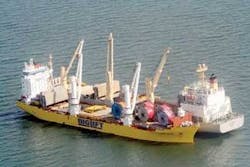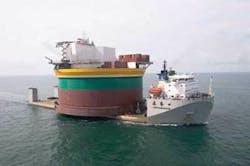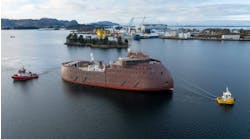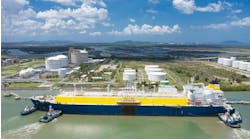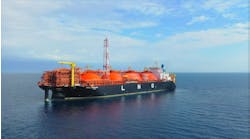Remote, deepwater operations impose greater demands on subsea contractors. Offshore West Africa, logistical support is still constrained, even in fast-developing countries such as Angola. On Mauritania’s coast, it was virtually non-existent before Woodside’s Chinguetti oilfield development.
For BigLift Shipping, even finding a berth to offload cargoes turned out to be an ingenuity test. The Amsterdam-based company was responsible for transporting umbilical and flowline reels from northern Europe to the installation contractor, Subsea7.
According to BigLift’s managing director, Arie Peterse, the bidding process for this type of project is complicated, with heavy emphasis on insurance, crew auditing, and other quality assurance issues. It was also the first time Subsea7 had taken on a project of such scope in that part of the world.
The contractor wanted the reels transferred directly from the transportation ship onto the deck of the installation vessel, in this case theToisa Perseus. “For that type of operation, you need a transportation vessel with sufficient lift capacity, and a crew that can manage the task,” Peterse points out. “Having in place the capability and quality control procedures involves much more work than a routine heavy lift.”
Normally, BigLift would pick up the base load for a subsea project from one site. In this case, however, consignments had to be collected from Newcastle, England (Wellstream); Rosyth, Scotland (Oceaneering Multiflex); and Le Trait in northern France (Technip). The company therefore assigned two of its fleet, theDa Qiang and the Happy Rover.
Da Qiang was one of two BigLift vessels transporting reels to Chiguetti.
In addition, Subsea7 used one of its own barges to pick up ancillary items such as spool pieces from the company’s base in Norway. “Our vessels had to be ready when theirs arrived at the location for equipment transfer. This involved a lot of coordination with the client - with the vessels moving at different transit speeds, this was logistically quite something.”
On arrival in Mauritanian waters in summer 2005, timing of deliveries was dictated by progress of the work offshore. “The main concern for Subsea7 was if theToisa Perseus became idle, as this vessel and its spread was the most expensive item of equipment on the field,” Peterse says. “Part of our role was to keep their vessel usefully occupied.
“With this project, there were some delays in drilling the wells. Subsea7 therefore had to alter its schedule to work around drilling operations. But this was also difficult for us, as we never knew how long this situation would last.” BigLift’s contract involved a lump-sum payment plus a day-rate for the number of days spent in port. TheDa Qiang was obliged to lay up for three weeks in Mauritania, while the Happy Rover had to spend around 100 days in port, longer than anticipated.
Nouakchott was the closest port to the offshore location, but it had only one jetty, built directly into the Atlantic Ocean, and this was not well protected. “To effect equipment transfers between two vessels, you cannot allow much movement of the ships,” Peterse explains. Operations therefore were shifted partly to Maoudibouh, a day’s steering to the north. “Facilities there were even less developed, but they were in sheltered water, so there was no influence of swell. We could undertake all preparations for our vessels there.”
Reel storage on the vessels was a lesser issue. “We employed load spreading and standard lashing systems in the usual way. For our part of the project, there was not much direct involvement with Woodside, apart from meetings with inspectors during discussions on safety and quality assurance. Luckily, there were no unusual incidents, and no personal injuries whatsoever.”
Once the equipment had been discharged, the BigLift ships brought all 28 empty reels and the pipelay equipment back to Newcastle and Le Trait. “Reels are on daily hire, and with subsea activity currently so high, clients are keen to have them back as soon as possible.”
Far East focus
Recently, BigLift undertook another long-haul operation to take 12 reels from northern Europe to New Zealand, for Shell Todd’s Pohokura project. For this assignment, the vesselTransporter sailed west via the Panama Canal, a 35-day transit. Seafastenings were designed to withstand bad weather along the route. The main weather event was snow on arrival in New Zealand, where the reels were discharged onto the Rockwater 2.
Sevan Marine’s SSP300Piranema FPSO was discharged in Rotterdam on May 25, 2006, after being transported onboard COSCOL’s semisubmersible heavy lift ship Kang Sheng Kou from China. According to NMA Maritime, the unique design of Sevan’s SSP300 allowed for the first ever dry transport of an FPSO, resulting in a quicker transit than would be possible with a wet tow. Meanwhile, COSCOL and Sevan Marine have finalized contracts for the transportation of two additional SSP300 FPSOs in 2007.
Elsewhere, BigLift vessels have undertaken the first of two shipments of around 30 reels from NKT in Denmark to an ONGC field in India. Another vessel is about to load for a delivery to Murphy’s Kikeh development off Malaysia. Next year, Technip has booked two of the company’s Happy R fleet for Chevron Nigeria’s Agbami project.
“Overall, bidding for offshore transportation is extremely busy,” says Peterse. “For us, two or three big offshore jobs are feasible per year, depending on how many vessels are needed and how long they have to be in port. One thing we realize is that we need to invest in more cabins on our vessels to accommodate our clients’ surveyors, supervisors, and inspectors. The offshore industry is far more demanding in that respect, even than customers with shipments of nuclear reactors.”

